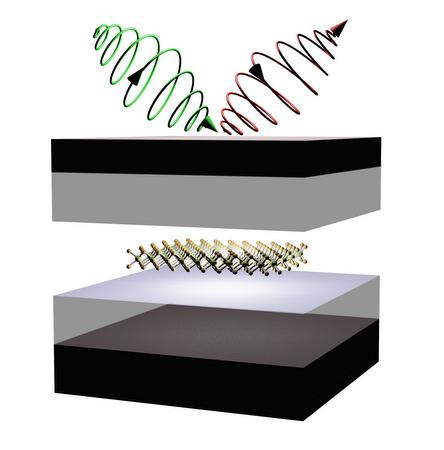
Schematic showing control of valley properties in 2D semiconductors embedded in microcavity. Image courtesy: Zheng Sun
While the charge and spin properties of electrons are widely utilized in modern day technologies such as transistors and memories, another aspect of the subatomic particle has long remained uncharted. This is the “valley” property which has potential for realizing a new class of technology termed “valleytronics” – similar to electronics (charge) and spintronics (spin). This property arises from the fact that the electrons in the crystal occupy different positions that are quantum mechanically distinct.
Now City College of New York physicists led by Vinod Menon have demonstrated how to manipulate the “valley” property using light by placing two-dimensional semiconductors in a light trapping structure called microcavity. This gave rise to half-light-half matter quasi-particles which have the fingerprint of the “valley” property. These quasi-particles were then optically controlled using a laser to access the electrons occupying specific “valley.” The research appears in the latest issue of “Nature Photonics” and is a major step towards realization of “valleytronic” devices for logic gates.
“Observing this property in traditional semiconductors was not easy. However with the advent of the new class of two-dimensional semiconductors, this property became accessible to manipulation,” said Zheng Sun, a graduate student in Menon’s research group and lead author of the paper.
Other researchers included CCNY graduate students, Jie Gu and Christopher Considine; undergraduate Michael Dollar, postdoctoral researcher Biswanath Chakraborty, Zav Shotan, and Xiaoze Liu; physics professor Pouyan Ghaemi and his postdoctoral researcher Areg Ghazaryan; and Stephane Kena-Cohen (Ecole Polytechnic, Montreal, Canada) also participated in the study.
The work was supported by the NSF through the EFRI 2-DARE program, the ECCS division, the Columbia-CCNY NSF MRSEC Center, the US Army Research Office and a Discovery grant from the Natural Sciences and Engineering Research Council of Canada.
About The City College of New York
Since 1847, The City College of New York has provided low-cost, high-quality education for New Yorkers in a wide variety of disciplines. Today more than 16,000 students pursue undergraduate and graduate degrees in eight professional schools and divisions, driven by significant funded research, creativity and scholarship. Now celebrating its 170th anniversary, CCNY is as diverse, dynamic and visionary as New York City itself. View CCNY Media Kit.
Jay Mwamba
p: 212.650.7580
e:
jmw%61mb%61@ccny.cu
%6ey.ed%75" rel="nofollow">
jmwamba@ccny.cuny.edu
View CCNY Media Kit